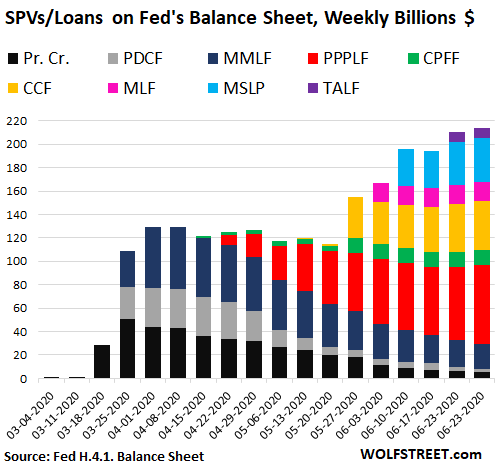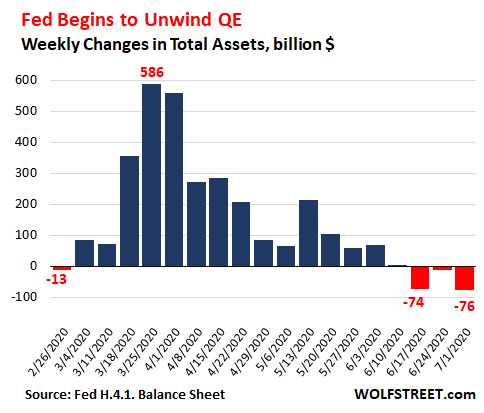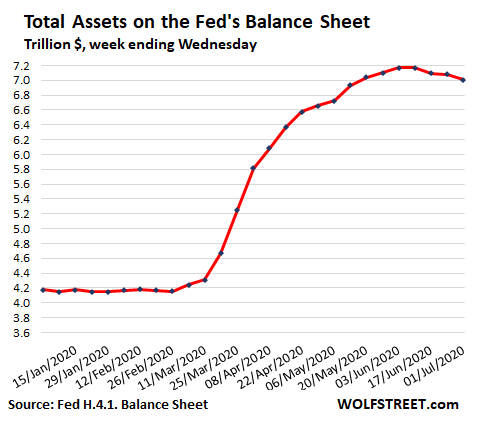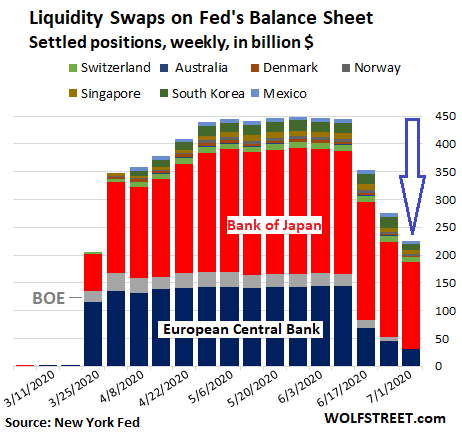QE Unwinds: Fed’s Assets Drop for 3rd Week, Another -$76 Billion. 3-Week Total: -$163 Billion
by Wolf Richter, Wolf Street:
 Fed shifts to propping up consumption by businesses and governments, and away from propping up asset prices.
Fed shifts to propping up consumption by businesses and governments, and away from propping up asset prices.
The Fed added some assets and shed other assets, and the net effect on the balance sheet for the week ended July 1, released Thursday afternoon, was that total assets dropped by $76 billion, after having dropped by $12 billion a week ago, and by $74 billion two weeks ago. That three-week drop of $163 billion was far faster than any three-week decline during the official QE unwind from late 2017 into 2019:

The chart above shows how the Fed front-loaded QE when the crisis erupted, throwing $1.5 trillion at it in the first four weeks, when financial markets came unglued and when credit was freezing up, and when investors in overleveraged hedge funds, mortgage-REITs, and other risk-takers were about to learn a lesson about capitalism – which the Fed’s bailout made sure they didn’t have to learn.
The $163-billion decline in total assets over the past three weeks brought the Fed’s assets down to a still mind-blowing $7.01 trillion.
The curve in the chart below shows the sudden ramp-up, the fairly quick taper, and then, over the past three weeks the drop. This was planned from the beginning: Give it all up-front but don’t let it drag out for years as last time:

Central-bank liquidity-swaps dropped by $50 billion.
The Fed’s “dollar liquidity swap lines” with other central banks fell by $50 billion in the week ended July 1 to $225 billion, the third week in a row of declines. They have now dropped by half over those three weeks.
To enter into a swap, the Fed lends newly created dollars to another central bank and takes their newly created domestic currency as collateral. The swap lines drop when swaps mature and the Fed gets its dollars back. The fact that maturing swap aren’t rolled over into new swaps shows that other central banks don’t need the dollars any longer:

Fed Alphabet-Soup of SPVs & Loans edged up by $3 billion.
The Fed has by now created a bunch of these Special Purpose Vehicles (SPVs), that, as it says, are authorized under Section 13 paragraph 3 of the Federal Reserve Act, as amended by the Dodd-Frank Act, which is why Jerome Powell calls them “thirteen-three facilities.” The first line, Primary Credit, contains loans made directly to lenders:
- Primary Credit (Pr. Cr. on the chart below)
- PDCF: Primary Dealer Credit Facility
- MMLF: Money Market Mutual Fund Liquidity Facility
- PPPLF: Paycheck Protection Program Liquidity Facility
- CPFF: Commercial Paper Funding Facility
- CCF: Corporate Credit Facility: SMCCF (Secondary Market Corporate Credit Credit) and PMCCF (Primary Market Corporate Credit Facility)
- MSLP: Main Street Lending Program
- MLF: Municipal Liquidity Facility
- TALF:Term Asset-Backed Securities Loan Facility
The Treasury Department puts equity capital – taxpayer money – into each of these SPVs as loss protection for the Fed. The Fed lends to the SPV at a leverage ratio of 10 to 1. The SPV then buys securities.
All those SPVs combined now carry a balance of $214 billion, up $3 billion from a week ago. The largest are:
- PPPLF (red column in the chart below), which buys PPP loans from banks. It grew by $6 billion last week to $68 billion, accounting for 32% of the total alphabet soup.
- CCF (yellow) rose a smidgen to $42 billion, accounting for 20% of the alphabet soup. This SPV buys corporate bonds, bond ETFs, and corporate loans.
- MSLP (baby-blue) remained flat at 37.5 billion, accounting for 18% of the total. This SPV buys loans from banks that banks have extended to small and medium-size businesses.
- MMLF (dark-blue), the money-market bailout SPV, has declined from $53 billion in early April to $21 billion now, accounting for 10% of the total.
The big three SPVs and loans in March are fading away. But new SPVs have sprung up. The latest creation is the resurrection of TALF two weeks ago (top purple). It has stayed flat at $8.8 billion. This SPV lends to investors against asset backed securities, such as subprime credit card ABS and other structured assets on a non-recourse basis. If this bet blows up, investors wash their hands off it, and the SPV eats the debris.
But the astounding thing about all these SPVs is this: After three months of ceaseless hype in the media about the hundreds of billions of dollars each would purchase, amounting to trillions of dollars in total, those SPVs now only hold $214 billion in assets combined. By Fed standards, they just haven’t bought much:

Treasury securities rise by $21 billion
The balance of Treasury securities rose by $21 billion during the week, to $4.2 trillion. Over the past six weeks, the balance increased in the same range between $9 billion and $26 billion a week. Note the front-loading of QE:



